Emperor penguins, pine cones, and mussels all feature special mechanisms that Torben Lenau is working to transfer to the world of sport.
Nature is the main source of inspiration when Torben Lenau ponders how to develop the sports technologies of the future, picking up ideas from emperor penguins, sharks, geckos, and pine cones. One of his objectives is to transfer mechanisms from animals that run and jump to a shoe that assimilates the athlete’s energy and uses it to help him/her run farther and faster. Another has to do with utilizing the speed of the emperor penguin— although he is still not quite sure how best to use it.
The associate professor from DTU Mechanical Engineering is a graduate engineer in the field of biomimetics, which involves working systematically to derive principles from nature and transfer them to solutions that can be achieved technologically.
Torben Lenau uses biomimetics as inspiration in developing everything from new sports technologies and surface techniques to waterless toilets and artificial limbs. He often develops his ideas in partnership with students from DTU and the University of Copenhagen.
Improved training methods
“My students provide a lot of useful input when we work together on developing ideas. Plants and animals have been evolving for centuries, coming up with solutions to many of the problems we are still battling in our everyday lives. They are constantly adapting to their surroundings, and we would do well to draw inspiration from their remarkable ability,” says Torben Lenau.
"Plants and animals have been evolving for centuries, coming up with solutions to many of the problems we are still battling in our everyday lives. They are constantly adapting to their surroundings, and we would do well to draw inspiration from their remarkable ability."
Torben Lenau, Associate Professor, DTU Mechanical Engineering
He believes that DTU already encompasses many disciplines with the potential not only to drive sports technology forward, but also to help athletes achieve maximum performance during training.
“In actual fact, sports technology is weird. Back in ancient Greece, athletes performed without shoes or clothes. Competition at that time was based exclusively on what the human body could achieve. It is a highly technological field today. Take a cyclist for example; in this context we can work to develop his bike, clothes, and helmet. All kinds of things have become essential in achieving optimal performance. Where we from the world of research come in is through our capacity to help athletes train better and thus perform to the best of their ability,” he adds.
More accurate information
Torben Lenau believes that tomorrow’s technologies will provide more accurate information than their predecessors. By taking measurements directly on the skin or close to the blood vessels, you can collect information about heart rate, for example, and use this to determine whether to run faster, slower or at intervals. The technologies can be designed as watches or small devices worn in the ear and fitted with sensors connected to a smartphone. There are all kinds of technological possibilities, but for Torben Lenau, development has to stop at the physical limits:
“From a purely sporting perspective, you can keep on improving your performance almost indefinitely, but it’s surely against the very spirit of sportsmanship to make yourself better than you actually are? Some runners at this year’s Paralympics used artificial legs whose design was inspired by the cheetah. Remarkably, many of these athletes were able to run faster than their able-bodied counterparts. The artificial limbs quite simply gave them greater strength. So does this mean it’s OK to fit a weightlifter with an exoskeleton so that he can lift hundreds of kilos?” he asks.
“I don’t think that’s sportsmanlike behaviour. So that’s where I draw the line. Let’s keep things fair.”
Pine cones
Pine cones are tightly closed while they grow, to protect the seeds they contain under the individual shells. When the cones dry, they open up and allow the seeds to drop out. This is possible due to the structure of the the individual shells, which consist of two layers that contract differently when they dry. A similar two-layer mechanism can be used to create small flaps for making adjustable prosthetic limbs and shoes. |

|
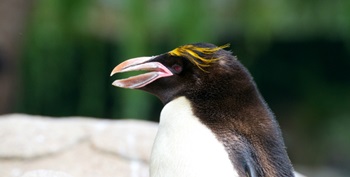 |
Emperor penguin
Emperor penguins can double their speed by lifting up their feathers and releasing air bubbles, enabling them to shoot out of the water like a projectile. They are skilled at both increasing their speed and reducing water resistance. Both mechanisms hold interesting perspectives.
|
Mussel
Mussels stick to stones, columns and other mussels using special threads known as byssus filaments. These filaments are ultra-thin and designed in such a way that they repair themselves when microscopic cracks arise. It may be possible to use this mechanism to make self-repairing sails for sports sailing boats.
|
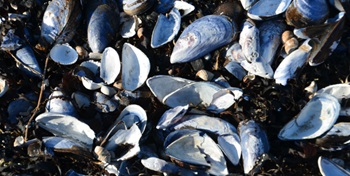 |
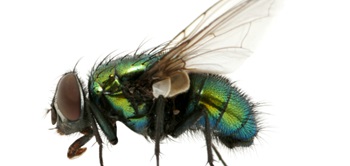 |
Bluebottles
Bluebottles can open and close gaps in their shells using knobbly elastic membranes. Pulling on the membrane reduces the size of the bumps. If you imagine a layer of elastic bumps in a sock on your foot, you could create a shoe that automatically adjusts its size when the foot expands.
|
Cheetah
An artificial limb inspired by the cheetah was developed for this year’s Paralympic Games. It takes the form of a hook that the athletes run on. What makes it really special, though, is that it allows Paralympic athletes to run faster than their able-bodied counterparts because it absorbs running energy better than human tendons and muscles. As such, it makes the athletes’ bodies stronger.
|
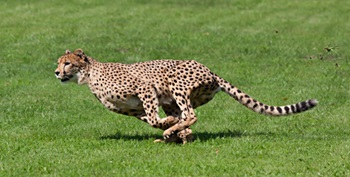 |
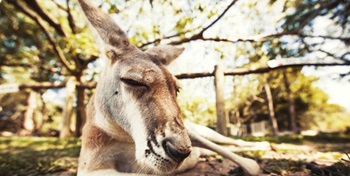 |
Kangaroo
The kangaroo becomes more and more efficient the faster it runs, while we humans become less and less efficient. The advantage the kangaroo enjoys is its capacity to coordinate its pulse and breathing to collect energy—and it breathes out at the same time as it pushes off. Athletes can use this mechanism to design techniques for their training programmes.
|